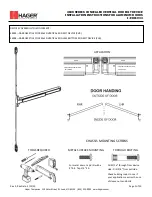
VeriFast
TM
LVDT – User Manual – FDP-VFA-LVD-UM-EL-1.15-0918
25
Determining Resolution – A Practical Example:
Sensor: VeriFast LVDT
Stroke Length: 22 mm (0.866”)
Output Range: 0-10 V DC
Noise Level: 10 mV
In this example, the infinitely variable output signal of the LVDT sensor is limited by the fact that
there is 10 mV of noise present on the signal lines. Since 10 mV is 1/1000th of the entire 0-10 V
range, the smallest position change that can be detected is 1/1000th of the working stroke
range of 22 mm (0.866”)
22 mm /1000 = 0.022 mm (0.866” / 1000 = 0.000866”)
So a good, practical estimate of the resolution is 0.022 mm (0.00087”)
Assuming a lower noise level would result in a better estimated resolution (e.g., 5 mV =
0.011 mm (0.0004”))
Input Resolution
–
Analog inputs on
industrial
controls must
“digitize” an
analog signal in order
to utilize the information. This is accomplished using an Analog-to-Digital Converter (ADC). An
ADC accepts the analog signal and assigns a discrete, digital value to a defined signal value.
For example, a 15-bit ADC can represent a 0-10 V signal as any one of 32,768 “numbers” (2
15
=
32,768). Using the above example:
22 mm / 32,768 = 0.0006713 mm (0.866” / 32,768 = 0.0000264”)
Important!
– Note that, in the above example, the limitation as a result of noise is still the
determining factor. Even though the input resolution can be as good as 0.0006713 mm
(0.0000264”), the 10 mV noise level would still limit practical resolution to 0.022 mm (0.00087”).
Establishing the Pneumatic Service Connection
The primary function of the compressed air supplied to the VeriFast LVDT is to control the
actuation of the weld pin. Based on the Pin type (i.e., Retractable or Non-Retractable), type of
application (e.g., nut/stud welding, welding ring projections, clinching applications) and the
mount type of the Weld Body (e.g., base, clamp mount, etc.), use one of the pneumatic
configurations below.
















































